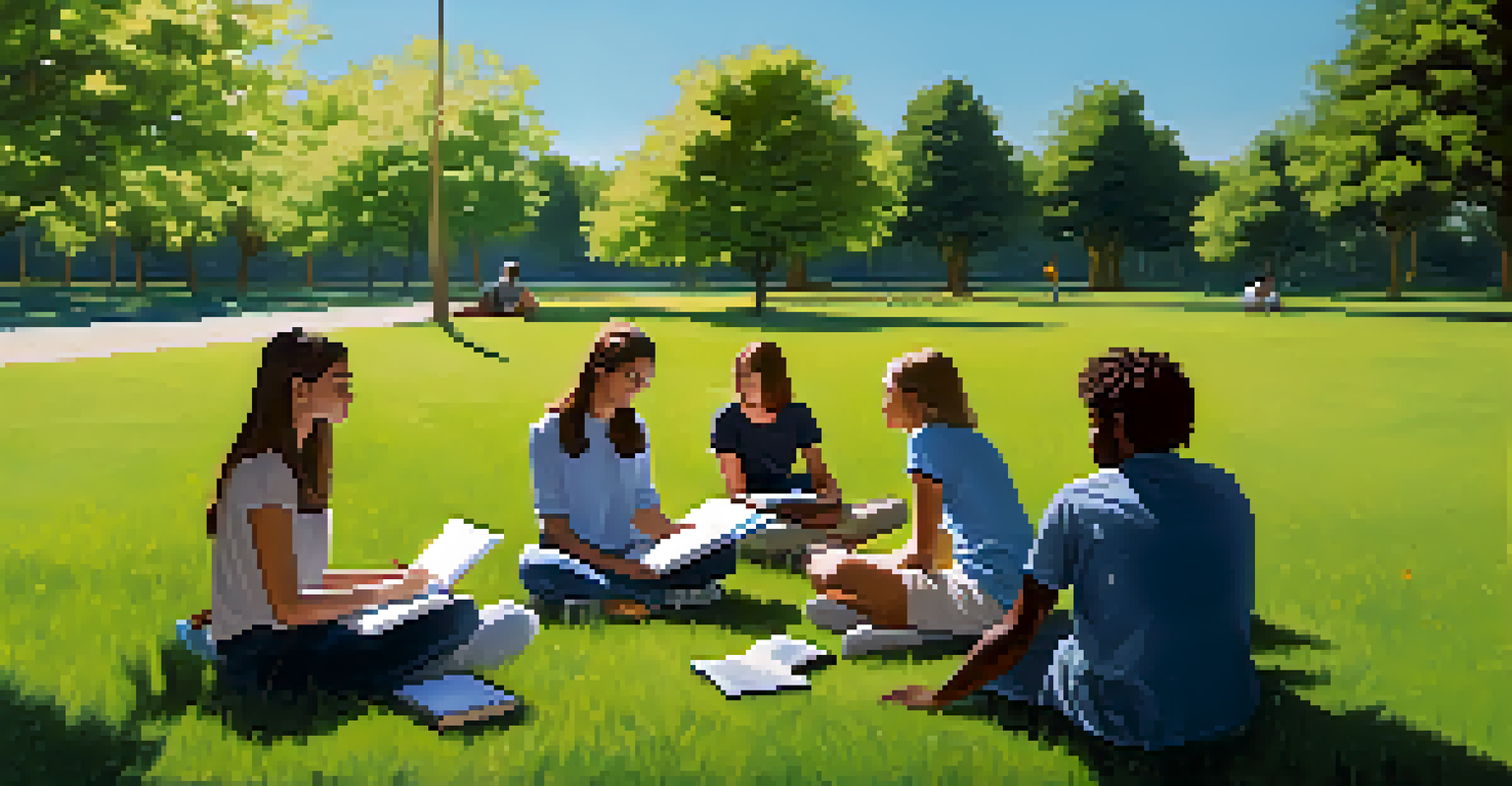The Role of Peer Learning in Future Education Models

Understanding Peer Learning and Its Importance
Peer learning is an educational approach where students learn from each other, fostering collaboration and mutual support. This method emphasizes shared knowledge rather than traditional teacher-centered instruction, making the learning process more engaging. By harnessing the strengths of diverse student backgrounds and skills, peer learning not only enhances comprehension but also builds confidence.
Tell me and I forget. Teach me and I remember. Involve me and I learn.
Imagine a classroom where students explain concepts to one another, transforming their understanding as they teach. This active participation encourages deeper cognitive processing, which is essential for long-term retention of information. As students articulate their thoughts, they clarify their own understanding while simultaneously helping their peers.
Moreover, peer learning cultivates essential life skills such as communication, problem-solving, and teamwork. These are crucial abilities in today’s interconnected world, preparing students for future workplaces where collaboration is key. In essence, peer learning transforms the educational landscape by making it more inclusive and dynamic.
The Evolution of Educational Models
Education has evolved significantly over the years, moving from rote memorization to more interactive and student-centered models. Traditional methods often left students passive recipients of information, but modern approaches prioritize active engagement and critical thinking. This shift is not only about what is taught but how it is taught, making peer learning a vital component.

In future educational models, the integration of technology plays a pivotal role in facilitating peer learning. For example, online platforms enable students to collaborate on projects regardless of their geographical locations, breaking down barriers that once limited educational exchanges. This accessibility ensures that diverse perspectives are brought into the learning process.
Peer Learning Enhances Engagement
Students actively participating in peer learning foster collaboration and build confidence through shared knowledge.
As educational paradigms continue to shift, the role of peer learning becomes even more pronounced. It aligns seamlessly with the demands of a rapidly changing world, where adaptability and lifelong learning are essential. Thus, fostering a culture of peer learning is crucial for preparing students to navigate their futures.
Benefits of Peer Learning for Students
Peer learning offers numerous benefits for students, creating a supportive environment where they can thrive. One major advantage is the development of critical thinking skills. When students engage in discussions with their peers, they are challenged to consider different viewpoints, leading to a more nuanced understanding of complex topics.
The whole is greater than the sum of its parts.
Additionally, peer learning enhances motivation and accountability. Students are more likely to stay engaged and complete tasks when they know their peers are relying on them. This sense of camaraderie not only fosters a supportive learning environment but also encourages students to take ownership of their education.
Lastly, peer learning helps to reduce anxiety and build confidence. Many students feel more comfortable sharing their ideas with peers than with teachers, promoting a sense of belonging. This supportive atmosphere can lead to improved academic performance and a more positive attitude towards learning.
Challenges of Implementing Peer Learning
While peer learning has many benefits, it is not without its challenges. One major hurdle is ensuring that all students are equally engaged and contributing to the learning process. Some students may dominate discussions while others remain passive, leading to an imbalance in participation and learning.
Moreover, the effectiveness of peer learning often depends on the group dynamics. If students do not feel comfortable with their peers or lack mutual respect, the learning experience can be hindered. It is crucial for educators to foster a positive classroom environment that encourages collaboration and open communication.
Technology Boosts Peer Learning
Digital tools and platforms facilitate collaboration, allowing students to connect and share ideas beyond traditional classroom boundaries.
Lastly, educators must also consider the varying levels of knowledge and skills among students. Peer learning works best when group members have comparable levels of understanding, but this is not always the case. Therefore, teachers need to carefully group students to ensure a balanced learning experience.
Role of Technology in Peer Learning
Technology plays a transformative role in enhancing peer learning experiences. Online platforms and tools facilitate collaboration among students, making it easier for them to share resources and ideas. For instance, tools like Google Docs allow multiple students to work on a project simultaneously, fostering real-time feedback and discussion.
Moreover, technology enables students to connect with peers beyond their immediate classroom. Virtual study groups and forums allow for a broader exchange of ideas, exposing students to diverse perspectives that enrich their learning experiences. This global connectivity is invaluable in today’s increasingly interconnected world.
However, it’s important to remember that technology should complement, not replace, traditional peer learning methods. Balancing face-to-face interactions with digital collaboration can provide students with a comprehensive learning experience that harnesses the best of both worlds.
Peer Learning and Social Skills Development
Engaging in peer learning significantly contributes to the development of social skills. As students collaborate, they practice essential interpersonal skills such as active listening, empathy, and effective communication. These skills are vital not only in educational settings but also in personal and professional relationships.
For example, when students work together on a project, they must negotiate roles, share responsibilities, and resolve conflicts. These experiences teach them how to work as part of a team, which is a crucial skill in nearly every career. Such collaboration fosters trust and respect among peers, creating a positive learning environment.
Developing Essential Social Skills
Peer learning cultivates vital interpersonal skills such as communication and teamwork, preparing students for future personal and professional interactions.
Furthermore, peer learning encourages students to appreciate diversity. Interacting with classmates from different backgrounds and cultures broadens their understanding of the world, promoting inclusivity and acceptance. This exposure is essential for developing well-rounded individuals who can thrive in diverse environments.
Future Perspectives on Peer Learning in Education
Looking ahead, the role of peer learning in education is likely to expand further. As educational institutions embrace more innovative and flexible teaching methods, peer learning will be integral to these new approaches. This shift will help create a more adaptive learning environment that meets the diverse needs of students.
Additionally, as we continue to integrate technology into education, the potential for peer learning will only grow. With advances in virtual reality and AI-driven platforms, students may soon engage in peer learning experiences that were unimaginable just a few years ago. These technologies will create immersive environments where collaboration can thrive.

Ultimately, prioritizing peer learning in future education models can lead to a more engaged, empowered, and connected generation of learners. As we embrace these changes, we can look forward to fostering a culture of collaboration that enriches the educational experience for all.